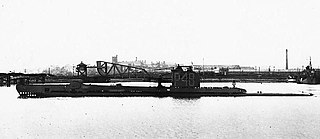At least five ships and one shore establishment of the Royal Navy have been named HMS Warrior:
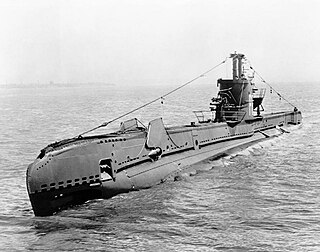
The S-class submarines of the Royal Navy were originally designed and built during the modernisation of the submarine force in the early 1930s to meet the need for smaller boats to patrol the restricted waters of the North Sea and the Mediterranean Sea, replacing the British H-class submarines. As part of the major naval construction for the Royal Navy during the Second World War, the S class became the single largest group of submarines ever built for the Royal Navy. A total of 62 were constructed over a period of 15 years, with fifty of the "improved" S class being launched between 1940 and 1945.
HMS Itchen may refer to one of the following British Royal Navy ships named after the English River Itchen:

HMS Charybdis was a Dido-class cruiser of the Royal Navy. She served during the Second World War and was sunk with heavy loss of life by German torpedo boats in an action in the English Channel in October 1943.

HMS Woodpecker, pennant number U08, was a Black Swan-class sloop of the Royal Navy. She was active during the Second World War and was a successful anti-submarine warfare vessel, being credited with the destruction of six U-boats.
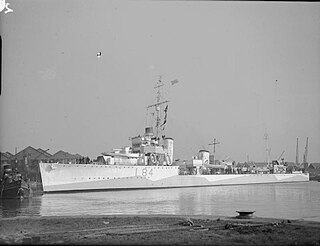
The Thornycroft type leader or Shakespeare class were a class of five destroyer leaders designed by John I. Thornycroft & Company and built by them at Woolston, Southampton for the Royal Navy towards the end of World War I. They were named after historical naval leaders. Only Shakespeare and Spenser were completed in time for wartime service. The other three were completed after the war, Broke and Keppel after being towed to Royal dockyards for completion, and two further ships - Saunders and Spragge - were cancelled. The function of a leader was to carry the flag staff of a destroyer flotilla, therefore they were enlarged to carry additional crew, offices and signalling equipment, allowing a fifth gun to be carried. These ships were very similar to the Admiralty type leader, but had broad, slab-sided funnels characteristic of Thornycroft designs.

HMS Blean was a Type III Hunt-class destroyer of the Royal Navy. She was named after the Blean Beagles Hunt at the village of Blean just north of Canterbury. She had the shortest career of any of the Hunt-class destroyers.
Two ships of the Royal Navy have been named HMS P36.
Two ships of the Royal Navy have been named HMS P38.
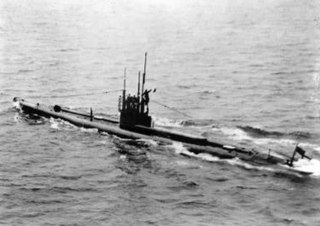
The F class submarine was built for the Royal Navy as a coastal submarine based on the doubled hulled V class submarine with very few minor improvements. The only important improvement was the addition of a stern torpedo tube. The F class were ordered as a successor to the E class submarine, but only three were built out of the ten ordered.

HMS Penylan was a Hunt-class destroyer of the Royal Navy. She was a member of the third subgroup of the class, and saw service in the Second World War, before being sunk by German E-boats in 1942.
Seven ships of the Royal Navy have borne the name HMS Sibyl or HMS Sybille, named for the Greek mythological figures, the Sibyls :
HMS Arabis was a Flower-class corvette of the Royal Navy. Originally ordered for the French Navy in the early days of the war, the ship was commissioned into the Royal Navy as HMS Arabis. She was transferred to the United States Navy in 1942, serving as USS Saucy. Returned to the United Kingdom in 1945, she was recommissioned into the Royal Navy as HMS Snapdragon.

HMS Wrestler (D35) was a W class destroyer launched by the Royal Navy in the latter stages of the First World War and active from 1939 to 1944 during the Second World War. She was the first Royal Navy ship to bear that name, and the only one to do so to date.
HMS Paragon was an Acasta-class destroyer that served in the Royal Navy during the First World War. She was launched in 1913, and joined the 4th Destroyer Flotilla upon completion. Serving with the Grand Fleet in August 1914, Paragon moved to the Humber in the summer of 1916, then to Portsmouth, then to Devonport by 1917. On 17 March 1917, fighting alongside HMS Llewellyn in an action in the Dover Strait with eight German torpedo boats, Paragon was sunk by torpedo.

HMS Vivacious (D36) was a V-class destroyer of the British Royal Navy that saw service in World War I and World War II.
HMS Veronica was a Flower-class corvette, built for the Royal Navy during the Second World War, and was in service in the Battle of the Atlantic. In 1942 she was transferred to the United States Navy as part of the reverse Lend Lease arrangement and renamed USS Temptress, the name ship of the Temptress-class gunboats. With the end of hostilities she was returned to the Royal Navy and sold into mercantile service.
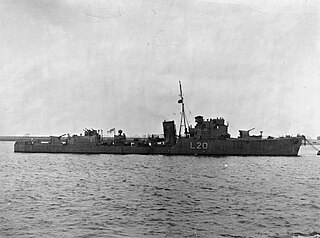
HMS Garth was a Type I Hunt-class destroyer of the Royal Navy built by John Brown & Company on the River Clyde, and launched on 28 December 1939. She was adopted by the Civil Community of Wokingham, Berkshire, as part of the Warship Week campaign in 1942.
James Joseph Colledge was a British naval historian, author of Ships of the Royal Navy, the standard work on the fighting ships of the British Royal Navy from the 15th century to the 20th century.

Ships of the Royal Navy is a naval history reference work by J. J. Colledge (1908–1997); it provides brief entries on all recorded ships in commission in the Royal Navy from the 15th century, giving location of constructions, date of launch, tonnage, specification and fate.

The International Standard Book Number (ISBN) is a numeric commercial book identifier which is intended to be unique. Publishers purchase ISBNs from an affiliate of the International ISBN Agency.


